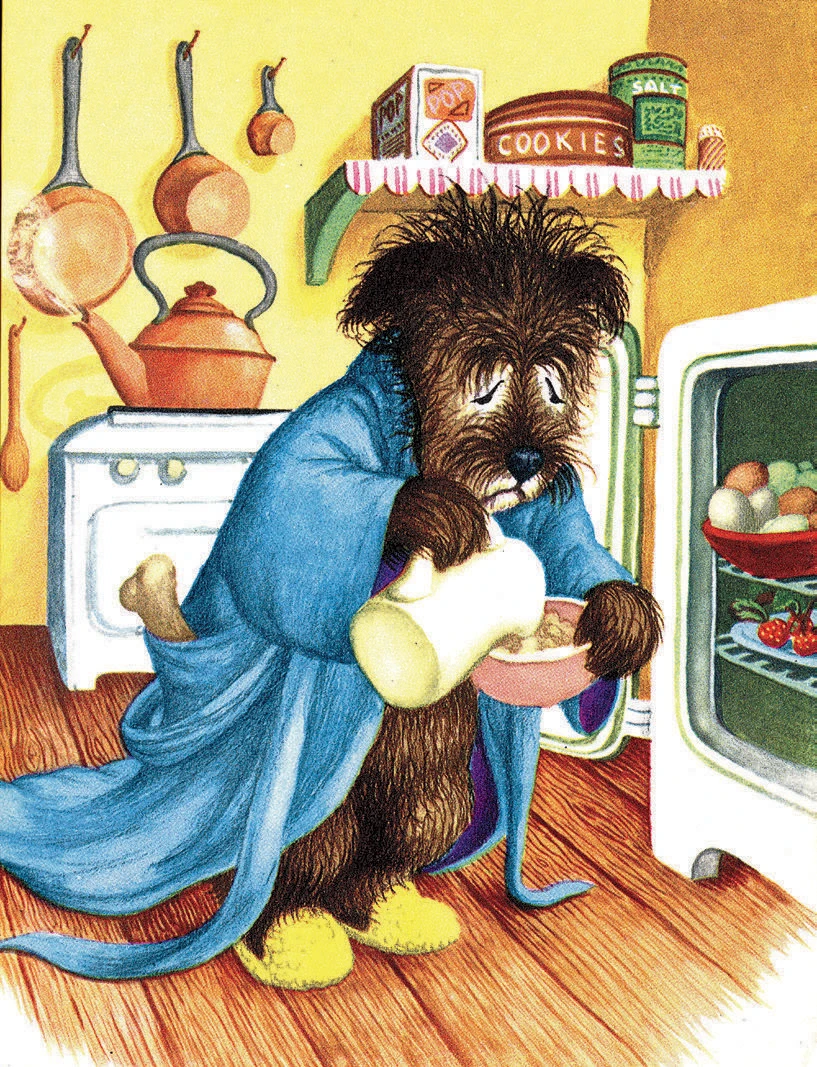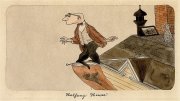The outré book designer and illustrator Edward Gorey ’50 spent a long career meticulously crafting works in a style that could be deemed charmingly sinister. His artistry, already evident while he was at Harvard, focused primarily on pen-and-ink drawings for hundreds of books, many favoring Victorian and Edwardian settings with narratives featuring off-kilter people and animals, oddly humorous deaths, and all manners of bad behavior. He was also a writer and crafter. He produced his own plays at his Cape Cod home, sewed puppets and stuffed animals, and expressed himself through stylish outfits, jewelry, and furs (although, as a lover of animals and especially cats, he stopped wearing animals later in life and ultimately bequeathed his estate to animal welfare organizations).
Houghton Library celebrates these signature talents and the centennial of his birth in Edward Gorey: The Gloomy Gallery, through January 12. Some 100 items are on display—books, theater posters, and toys, along with some never-before-seen drawings, like the Halfway House, inspired by the Signet Society building (recently acquired through a bequest by the estate of Gorey’s Eliot House roommate Anthony N. Smith ’37). “Many of our exhibits are intellectually driven, but this is more joy-driven,” allows Molly Schwartzburg, the library’s Hofer curator of printing and graphic arts. “We’re just giving people, especially our younger visitors, the experience of encountering Gorey and his half-creepy, half-cozy environment in our wonderfully antiquarian-feeling gallery.”
Objects are loosely grouped under Gorey’s own titles. Mercurial Bear looks at self-recreation through costumes, clothing, and performance, while The Curious Sofa offers dynamic “swooning, tilting, and reclining,” says Schwartzburg, as so many of his characters do. Gorey doesn’t fit into the horror genre “because he’s too neat and clean about it, but his subjects are horrifying,” she notes. The Loathsome Couple is based on English serial killers who kidnapped children and killed them in the 1960s, while The Gashlycrumb Tinies teaches the alphabet through children dying in 26 cleverly rhymed scenarios, which are darkly funny in a Roald Dahl way. “He was queer in the fundamental meaning of the word,” she adds. “Vague about his sexuality, he did not want to be pigeonholed; he was so comfortable not fitting into a comfortable category.” None of his books were made for children, yet many starred in them. Similarly, his rhymes and texts were poetic, but not poetry, and his stories visually driven, yet not comics or graphic novels. “What he did falls outside of all the boundaries but somehow appeals to a huge variety of people,” Schwartzburg says. “We hope visitors will feel like being in the gallery is a bit like hanging out in Gorey’s mind.”

USED WITH PERMISSION OF THE EDWARD GOREY CHARITABLE TRUST
Meanwhile, a second exhibit, Creature Comforts: 175 Years of Dogs and Cats at Home (through December 11), features actual children’s books—and the rich relationships between humans and their pets. See the beguiling books The Tale of Tom Kitten and The Story of Miss Moppet, by Beatrix Potter, along with The Cat That Went to College, Frances Frost’s 1951 tale of a stray cat taken in by Harvard students. The 1952 Mister Dog: The Dog Who Belonged to Himself , written by Margaret Wise Brown and illustrated by Garth Williams, features an anthropomorphized dog who adopts a boy. He teaches him how to enjoy free will and be self-reliant—but also how to thrive in a daily routine and keep things tidy. The underlying message seems to be that people can be themselves but there are important universal rules governing civility and self-possession. In a sense, both exhibits look at reverberating themes of how best to tame our animal instincts and fit ourselves productively into society while embracing individual freedom.









